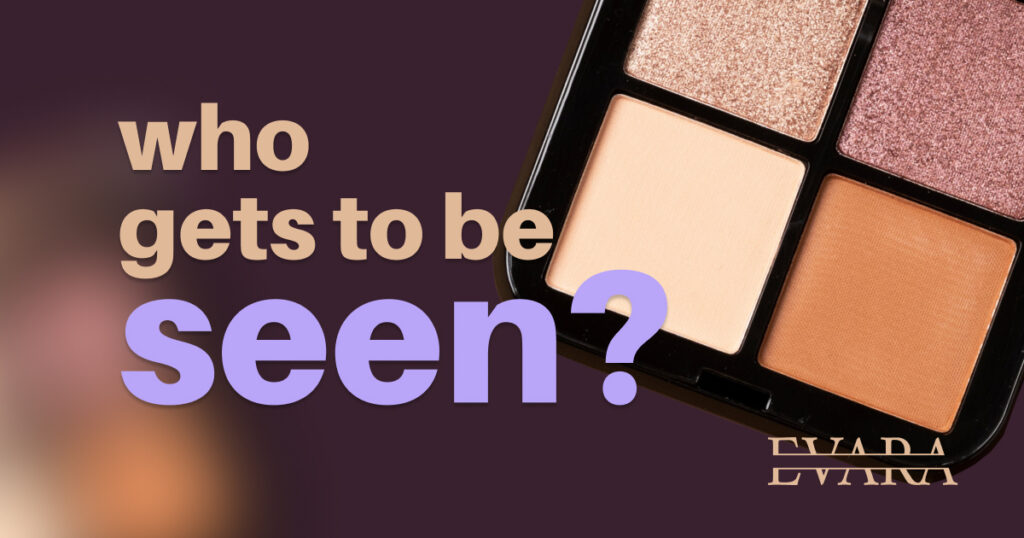
💄 Who Gets to Be Seen?
Makeup, Politics, Power, and the Faces We Choose to Look At
Makeup has never been just about beauty. It’s about visibility. And in a world where politics are personal and identity is policed, makeup becomes more than pigment—it becomes a declaration.
So, who gets to wear it? Who gets to be represented by it? Who profits from it? And who, still, is erased from the conversation entirely?
🌈 Makeup Is Political—Always Has Been
From ancient Egypt to punk subcultures, drag artistry, and TikTok beauty influencers, makeup has always carried meaning beyond the mirror. It can be a shield, a scream, a love letter to the self, or a rebellion against the norm.
But behind the glitter and gloss lies a complex web of beauty industry gatekeeping—fueled by race, gender, capitalism, and power dynamics.
🚻 Who Gets to Wear Makeup?
Makeup has traditionally been marketed as a tool for cisgender women to enhance femininity—but what about everyone else?
🧑🎤 Queer & Gender-Nonconforming Faces
Makeup can be life-saving armor for trans, nonbinary, and genderfluid people. It’s a way to be seen as we are—or how we wish to be. Yet, even as makeup becomes more “inclusive,” people outside the gender binary still face violence, ridicule, or erasure.
Think of drag queens who’ve shaped global beauty standards—yet are still considered “too much” for mainstream campaigns. Or the nonbinary teen wearing gloss on the bus, enduring stares or worse.
Visibility is not always safety.
Makeup might offer empowerment—but only to those allowed to wear it without punishment.
🧏🏾♀️ Who Gets to Be Seen in Makeup?
Even as the global beauty industry markets itself as diverse, it often falls short.
🟤 Skin Color and Shade Ranges
For decades, darker-skinned individuals, especially Black women, were excluded from foundation lines. Many brands offered 20 shades of beige and called it a range. That changed with Fenty Beauty’s launch in 2017, which exposed this failure and redefined industry standards.
But let’s not forget: it took a celebrity billionaire to finally make corporations listen.
Melanin shouldn’t be a trend.
It should have always been part of the palette.
🌍 Who Gets to Make Makeup?
Behind the scenes, beauty industry power structures become clearer. The majority of global cosmetics brands are still owned by white men, even though the products are consumed primarily by women, LGBTQ+ communities, and people of color.
🧪 Exploitation in Sourcing
Let’s talk talc, mica, and shea butter.
Many raw materials are sourced from India, Madagascar, and Ghana—often mined by women and children in unsafe, unregulated environments. Meanwhile, brands sell products for €40 a bottle under the label “clean” or “ethical.”
Is your “clean beauty” really clean if it’s built on invisible labor?
Even “sustainable” brands rarely provide ownership or profit-sharing to the communities they depend on.
👁 Who Gets to Be Beautiful?
The standard of beauty today is still shaped by white supremacy, patriarchy, ableism, and capitalism. The rise of the “Instagram face“—clear skin, soft contour, almond-shaped eyes—is not accidental. It’s algorithm-approved aesthetics that erase many.
What about:
- People with vitiligo, scars, or textured skin?
- Hijabi makeup artists told their looks are “too religious”?
- Indigenous creators excluded from global beauty markets?
- Fat, disabled, or neurodivergent faces absent from brand ads?
Makeup is supposed to amplify identity.
So why does the industry keep narrowing it?
🛍 What Does Liberation Look Like in Beauty?
To decolonize beauty is more than featuring “diverse” faces in a seasonal campaign. It’s about redistributing power across the supply chain, leadership, and representation.
Real Liberation Includes:
- Brands giving equity to BIPOC founders
- Transparent and ethical supply chains
- Platforms that amplify queer, disabled, and marginalized artists—consistently, not just for Pride Month or trending topics
- Representation that moves from visibility to authorship
Makeup doesn’t need to be apolitical.
In fact, it shouldn’t be.
It’s one of the few things that touches our faces daily—if something is that intimate, it should also be honest.
✨ Final Words: “Who Gets to Be Seen” Is Still the Question
Not just in front of the camera, but behind it. In labs. On factory floors. On TikTok. In rural clinics. In drag basements. In school bathrooms. In Gaza. In Ghana. In Georgia.
Makeup is a mirror of the world we live in.
The question is—whose reflection are we still leaving out?
❓ Frequently Asked Questions (FAQs)
1. Why is makeup considered political?
Because it intersects with race, gender identity, class, and power dynamics, makeup becomes a symbol of inclusion or exclusion.
2. How does the beauty industry exclude marginalized groups?
Through limited shade ranges, underrepresentation, cultural gatekeeping, and exploitation in supply chains.
3. What was the impact of Fenty Beauty on inclusivity?
It exposed the lack of diversity in foundation ranges and forced the industry to rethink shade offerings and what “inclusive beauty” actually means.
4. What does “clean beauty” mean, and is it really ethical?
“Clean beauty” often refers to products without harmful chemicals—but many are built on exploited labor and unsustainable sourcing, making the term questionable.
5. How can makeup be liberating for queer and trans individuals?
It allows for gender expression, visibility, and self-affirmation—especially in a society that often erases non-cis identities.
6. What does decolonizing beauty actually involve?
Shifting power, ownership, and authorship back to the communities that have historically been marginalized or commodified.